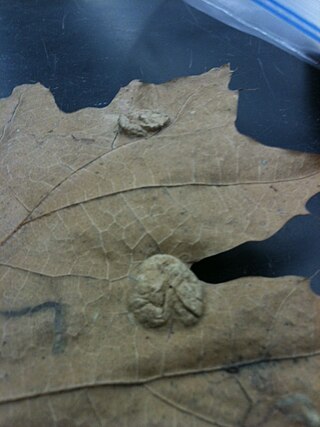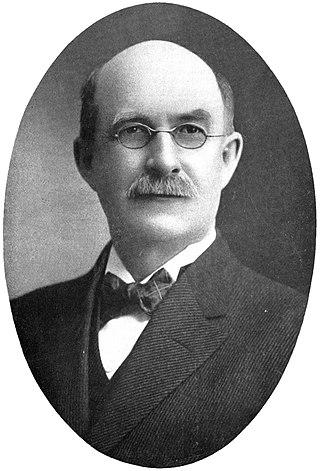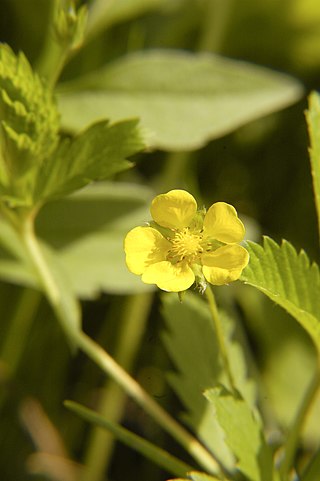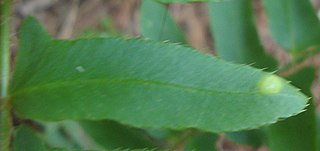
Taphrina is a fungal genus within the Ascomycota that causes leaf and catkin curl diseases and witch's brooms of certain flowering plants. One of the more commonly observed species causes peach leaf curl. Taphrina typically grow as yeasts during one phase of their life cycles, then infect plant tissues in which typical hyphae are formed, and ultimately they form a naked layer of asci on the deformed, often brightly pigmented surfaces of their hosts. No discrete fruit body is formed outside of the gall-like or blister-like tissues of the hosts. The asci form a layer lacking paraphyses, and they lack croziers. The ascospores frequently bud into multiple yeast cells within the asci. Phylogenetically, Taphrina is a member of a basal group within the Ascomycota, and type genus for the subphylum Taphrinomycotina, the class Taphrinomycetes, and order Taphrinales.

Taphrina deformans is a fungus and plant pathogen, and a causal agent[s] of peach leaf curl. Peach trees infected with T. deformans will experience leaf puckering and distortion, acquiring a characteristic downward and inward curl. Leaves will also undergo chlorosis, turning a pale green or yellow, and later show a red or purple tint. Fruit can either drop prematurely or show surface distortions. Severe infection can also produce lesions on the flowers. The host tree will experience defoliation if the leaves are badly diseased. If a seedling is severely infected, it may die. Almond trees display similar symptoms.
Taphrina ulmi is a species of fungus in the family Taphrinaceae. A plant pathogen, it causes leaf blister galls on elm trees.
Septogloeum potentillae is an ascomycete fungus that is a plant pathogen infecting strawberries. The species' validity is considered unconfirmed by GBIF, as it has very few occurrences, and has not been described in published literature for over a century.

Roland Thaxter was an American mycologist, plant pathologist, botanist, and entomologist, renowned for his contribution to the insect parasitic fungi—Laboulbeniales. His college education was completed at Harvard, where he dedicated forty years to mycological and botanical research. His five-volume series on fungi in the order Laboulbeniales laid a solid foundation of research on these insect ectoparasites. He also contributed to the field of Plant Pathology.

The Mixiomycetes are a class of fungi in the Pucciniomycotina subdivision of the Basidiomycota. The class contains a single order, the Mixiales, which in turn contains a single family, the Mixiaceae that circumscribes the monotypic genus Mixia. Only one species has been described to date, Mixia osmundae; this species was originally named Taphrina osmundae by Japanese mycologist Toji Nishida in 1911. It is characterized by having multinucleate hyphae, and by producing multiple spores on sporogenous cells.

Coleophora potentillae is a moth of the family Coleophoridae. It is found from Fennoscandia to the Pyrenees, and from Ireland to Poland.
Taphrina bullata is an ascomycete fungus that is a plant pathogen. It causes leaf blisters on pear trees.
Taphrina entomospora is a fungal plant pathogen that infects the leaves of Nothofagus. T. entomospora infection results in chlorosis and changes in parenchyma structure of the leaf causing premature senescence. The species was first described scientifically by mycologist Roland Thaxter in 1910.

Taphrina wiesneri is a plant pathogen causing witch's broom, or plant gall formations, on cherry trees. It is an important pest species of the ornamental cherry Cerasus X yedoensis in Japan.

Taphrina caerulescens is a species of fungus in the family Taphrinaceae. It is a pathogenic Ascomycete fungus that causes oak leaf blister disease on various species of oak trees. The associated anamorph species is Lalaria coccinea, described in 1990. This disease causes lesions and blisters on Oak leaves. Effects of the disease are mostly cosmetic. Although not taxonomically defined, strains of T. caerulescens have been shown to be host specific with varying ¬ascus morphology between strains. There are differences in strains' abilities to metabolize various carbon and nitrogen compounds. This has been proposed as a method of taxonomically defining subspecies within T. caerulescens.
Edwin Bunting Bartram was an American botanist and bryologist. He described many dozens of new species in bryology, and contributed 143 works, including a number of books. He was a member of the Academy of Natural Sciences, Philadelphia Botanical Club, Torrey Botanical Club, New England Botanical Club, Sullivant Moss Society and British Bryological Society.

Edward Angus Burt was an American mycologist and an authority on the resupinate fungus family Thelephoraceae. He received his M.A. in 1894 and PhD. in 1895, both from Harvard University under William G. Farlow and Roland Thaxter. He became a Professor of Natural History at Middlebury College in 1895, then both a Professor of Botany at the Henry Shaw School of Botany at Washington University in St. Louis, and a mycologist for the Missouri Botanical Garden in 1913. He also worked on a systematic description of basidiomycetes such as Merulius and fungi from Vermont, Siberia, and Java.

Potentilla simplex, also known as common cinquefoil or old-field five-fingers or oldfield cinquefoil, is a perennial herb in the Rosaceae (rose) family native to eastern North America from Ontario, Quebec, and Labrador south to Texas, Alabama, and panhandle Florida.
Richard Emil Benjamin Sadebeck was a German pteridologist and mycologist. He was an older brother of mineralogist Alexander Sadebeck (1843–1879).

Potentilla canadensis, the dwarf cinquefoil, is a species of cinquefoil native to North America.
Diastrophus potentillae, also known as the cinquefoil bud gall wasp, is a species of gall wasp in the family Cynipidae. It is found in eastern North America. It makes galls on the stems of Potentilla canadensis and P. simplex.

Taphrina polystichi is an ascomycete fungus that parasitizes Christmas fern in eastern North America. It was described by A. J. Mix in 1938.

Taphrina tosquinetii is a fungal plant pathogen that causes large blisters on both surfaces of the leaves of alder.

Taphrina betulina is a fungal plant pathogen that causes the gall, witches broom, which is a chemical infection of birch buds or the developing shoots, leading to a proliferation of growth. It was first described by Emil Rostrup in 1883 and is found in Europe, New Zealand and North America.












